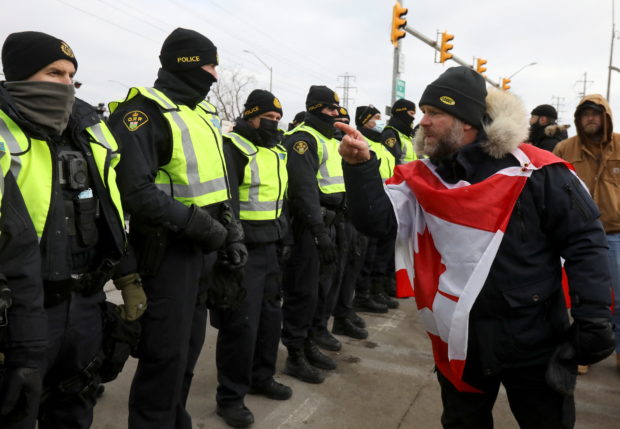
A protester gestures towards police officers, who stand guard on a street after Windsor Police said that they are starting to enforce a court order to clear truckers and supporters who have been protesting against coronavirus disease (COVID-19) vaccine mandates by blocking access to the Ambassador Bridge, which connects Detroit and Windsor, in Windsor, Ontario, Canada February 12, 2022. REUTERS/Carlos Osorio
WINDSOR, Ontario — A standoff between Canadian police and protesters blocking a key bridge to the United States continued on Saturday, more than seven hours after authorities moved in seeking to end the blockade of the important trade corridor.
Demonstrators opposing the government’s strict pandemic restrictions have occupied the Ambassador Bridge for the fifth straight day, snarling international trade and prompting President Joe Biden to call for an end to the siege. But there was still no sign when traffic would resume.
While police have successfully pushed back protesters from the foot of the Ambassador Bridge, more people were streaming into the area and the operation appeared to have stalled.
As the afternoon dragged on, some Canadians questioned what was behind the delay, given the order issued by a court on Friday to end the blockade and the imposition of a state of emergency declared by Ontario authorities.
“It would essentially send a message that the state is not able to retain control, where it’s attempted to do so,” Michael Kempa, an associate professor of criminology at the University of Ottawa, told CBC News.
“The longer this drags on, the longer people have the idea that what they are doing is not an illegal protest,” he said.
The Ambassador Bridge is North America’s busiest land border crossing. Since Monday, protesters in trucks, cars and vans have blocked traffic in both directions, choking the supply chain for Detroit’s carmakers.
The “Freedom Convoy” protests, started in the capital Ottawa by Canadian truckers opposing a vaccinate-or-quarantine mandate for cross-border drivers, entered its 16th day on Saturday. It has morphed into a wider protest against COVID-19 curbs, with people joining in with smaller vehicles, including cars, vans and pick-up trucks.
Early on Saturday, Windsor Police urged demonstrators to act lawfully and peacefully. Officers in black uniforms with yellow vests moved behind the demonstrators’ vehicles and, accompanied by police cruisers, slowly advanced on the protesters, pushing them back from the bridge entrance.
The number of demonstrators had thinned to roughly two dozen early on Saturday from about 200 on Friday night.
“We are opening up this intersection to traffic. If you fail to comply with our instructions you will be arrested,” police told the crowd via a loudspeaker.
Protesters moved back in a noisy but peaceful retreat, dismantling tents and barbecues. But since then, police have not progressed, witnesses said.
Ottawa Police said they were waiting for reinforcements to end the “unlawful occupation” in the capital. Demonstrators there “exhibited aggressive behavior towards law enforcement” and tore down a fence that had been erected around the National War Memorial.
Protests have spread to three border points: the Ambassador Bridge, strangling trade between the two countries, and two smaller crossings in Alberta and Manitoba.
Canadian police have said the protests have been partly funded by U.S. supporters and Ontario froze funds donated via one U.S. platform, GiveSendGo, on Thursday.
Toronto-Dominion Bank has frozen two personal bank accounts into which C$1.4 million ($1.1 million) had been deposited in support of the protesters.
Copycat protests
The protests have inspired similar convoys and plans in the United States, France, New Zealand and Australia.
In Paris, French police fired tear gas at demonstrators on the Champs Elysees avenue on Saturday shortly after a convoy carrying protesters against COVID-19 restrictions made it into the capital.
In Canada’s financial capital Toronto, police blocked main roads leading to the central business district, ahead of a planned protest on Saturday. A convoy of motorists in the United States is planning to head to the waterfront in Port Huron, Michigan, in support of protesters in Canada.
Another U.S. group said two separate vehicle convoys will converge this weekend at the Peace Bridge, another U.S.-Canadian border crossing in Buffalo, New York.
Ford, the second-largest U.S. automaker, General Motors and Toyota Motor Co all have announced production cuts. Companies have diverted cargo to stem losses amid production cuts.
The estimated loss from the blockades just to the automobile industry could be as high as $700 million, based on IHS Markit’s data, which puts the daily flow in vehicles and parts at $141.1 million day in 2021.
Prime Minister Justin Trudeau has come under pressure from opposition party leaders to intervene. Trudeau is scheduled to chair a meeting of his top advisors on Saturday, called the Incident Response Group, to discuss the situation.